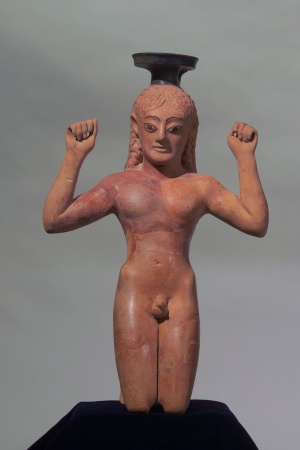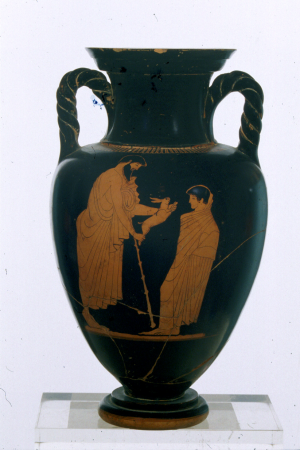(Boylove Documentary Sourcebook) - The Heterogeneity of Pederastic Desire Concerning the Physical Traits of Young Male Beloveds, as Stated in a Passage from the 'Republic' by Plato: Difference between revisions
Dandelion moved page (BLSB) - The Heterogeneity of Pederastic Desire Concerning the Physical Traits of Young Male Beloveds, as Stated in a Passage from the 'Republic' by Plato to [[The Heterogeneity of Pederastic Desire Concerning the Physical Trai... |
m Dandelion moved page (BLSB) - The Heterogeneity of Pederastic Desire Concerning the Physical Traits of Young Male Beloveds, as Stated in a Passage from the 'Republic' by Plato to (Boylove Documentary Sourcebook) - The Heterogeneity of Pederastic Desire Concerning the Physical Traits of Young Male Beloveds, as Stated in a Passage from the 'Republic' by Plato |
||
| (9 intermediate revisions by the same user not shown) | |||
| Line 1: | Line 1: | ||
# | [[File:Vase in the shape of a kneeling boy.jpg|thumb|center|Kneeling Boy. Archaic [[Ancient Greece|Greek]] ceramic <i>aryballos</i>, a vessel for perfume or oil, in the shape of a kneeling <i>diadumenos</i>, a victorious athlete binding a fillet around his head, ca. 540–530 B.C. Athens, Ancient Agora Museum, P 1231.]] | ||
From <i>Greek [[Homosexuality]]</i> by K. J. Dover (Cambridge, Massachusetts: Harvard University Press, 1989). First published by Gerald Duckworth & Co. in England in 1978. Footnote omitted. | |||
<div style="margin:.5em auto; width:95%; min-height:5em; background-color:#F5FAFF; border:3px solid #c9c9ff; padding:1em;"> | |||
[[Socrates]] chaffs Glaukon, who as an <i>erōtikos</i> should remember (474de) that | |||
<blockquote> | |||
<div style="font-size:92%"> | |||
when a man is a lover of boys and <i>erōtikos</i>, all those who are at the right age somehow or other get under his skin and turn him on; he thinks they’re all worth looking after and making a fuss of. Isn’t that how you behave to beautiful boys? If he’s got an upturned nose, you’ll call him ‘charming’ and sing his praises; if he’s got a hooked nose, you say he’s ‘aristocratic’ (<i>lit</i>., ‘kingly’), and of course, the one in between has exactly the right proportions. If they’re dark (<i>lit</i>., ‘black’), you say they look manly; if they’re fair (<i>lit</i>., ‘white’), they’re children of the gods. And do you think that the word ‘honey-yellow’ is anything but the endearment of an [[erastes]] who doesn’t mind a boy’s pallor, if he’s the right age? | |||
</div> | |||
</blockquote> | |||
</div> | |||
[[File:Man Offers a Hare as Love Gift to Boy.png|thumb|center|Man Offers a Hare as Love Gift to Boy. Attic red-figure neck-amphora by the Matsch Painter, c. 490 B.C. Rome, Museo Nazionale Etrusco di Villa Giulia, 50462.]] | |||
==See also== | |||
*[[Symposium (Plato)]] | |||
*[[Adult friend (dictionary)]] | |||
*[[Age of attraction (dictionary)]] | |||
*[[Athenian pederasty]] | |||
*[[Boylove]] | |||
*[[Cretan pederasty]] | |||
*[[Ephebophilia]] | |||
*[[Eromenos]] | |||
*[[Greek love]] | |||
*[[Historical boylove relationships in ancient Greece]] | |||
*[[Loved boy (dictionary)]] | |||
*[[Minor-attracted person (dictionary)]] | |||
*[[Pederasty in ancient Greece]] | |||
*[[Pedophilia]] | |||
*[[Philosophy of ancient Greek pederasty]] | |||
*[[Spartan pederasty]] | |||
*[[Theban pederasty]] | |||
*[[Young friend (dictionary)]] | |||
==External links== | |||
*[http://classics.mit.edu/Plato/republic.6.v.html <i>The Republic</i>. By Plato. Written 360 B.C.E. Translated by Benjamin Jowett - Book V (The Internet Classics Archive)] | |||
*[https://greek-love.com/antiquity/greek-practices/pursuit-and-flight-by-sir-kenneth-dover <i>PURSUIT AND FLIGHT</i> BY SIR KENNETH DOVER (Greek Love Through the Ages)] | |||
*[https://greek-love.com/antiquity/greek-practices/greeks-pedicate-loved-boys-pederasty DID THE GREEKS PEDICATE THEIR LOVED BOYS? (Greek Love Through the Ages)] | |||
[[Category:Boylove Documentary Sourcebook]] | |||
[[Category:Reference material on ancient Greece]] | |||
[[Category:Philosophical literature]] | |||
Latest revision as of 11:11, 3 November 2021

From Greek Homosexuality by K. J. Dover (Cambridge, Massachusetts: Harvard University Press, 1989). First published by Gerald Duckworth & Co. in England in 1978. Footnote omitted.
Socrates chaffs Glaukon, who as an erōtikos should remember (474de) that
when a man is a lover of boys and erōtikos, all those who are at the right age somehow or other get under his skin and turn him on; he thinks they’re all worth looking after and making a fuss of. Isn’t that how you behave to beautiful boys? If he’s got an upturned nose, you’ll call him ‘charming’ and sing his praises; if he’s got a hooked nose, you say he’s ‘aristocratic’ (lit., ‘kingly’), and of course, the one in between has exactly the right proportions. If they’re dark (lit., ‘black’), you say they look manly; if they’re fair (lit., ‘white’), they’re children of the gods. And do you think that the word ‘honey-yellow’ is anything but the endearment of an erastes who doesn’t mind a boy’s pallor, if he’s the right age?

See also
- Symposium (Plato)
- Adult friend (dictionary)
- Age of attraction (dictionary)
- Athenian pederasty
- Boylove
- Cretan pederasty
- Ephebophilia
- Eromenos
- Greek love
- Historical boylove relationships in ancient Greece
- Loved boy (dictionary)
- Minor-attracted person (dictionary)
- Pederasty in ancient Greece
- Pedophilia
- Philosophy of ancient Greek pederasty
- Spartan pederasty
- Theban pederasty
- Young friend (dictionary)